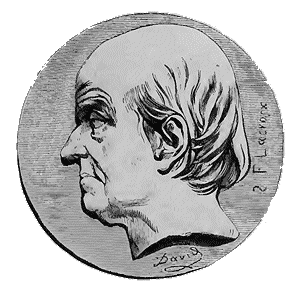Sylvestre François Lacroix facts for kids
Quick facts for kids
Sylvestre François Lacroix
|
|
|---|---|
 |
|
| Born | 28 April 1765 Paris, France
|
| Died | 24 May 1843 (aged 78) Paris, France
|
| Scientific career | |
| Fields | Mathematics |
| Academic advisors | Gaspard Monge |
Sylvestre François Lacroix (born April 28, 1765 – died May 24, 1843) was an important French mathematician. He is best known for writing many math textbooks that were used for a long time.
Contents
Early Life and Education
Sylvestre François Lacroix was born in Paris, France. Even though his family was not rich, they made sure he got a good education. His interest in math began when he read the book Robinson Crusoe. This story made him curious about sailing and navigation.
His interest in navigation led him to geometry, which is a branch of math about shapes and spaces. From there, he became interested in all parts of mathematics. He took classes from famous teachers like Antoine-René Mauduit and Joseph-Francois Marie. He also learned from Gaspard Monge, another well-known mathematician.
Teaching Career and Contributions
When he was only 17 years old, in 1782, Lacroix became a math teacher. He taught at the École de Gardes de la Marine in Rochefort. Later, he taught at other important schools in Paris, including the École Royale Militaire.
In 1787, he married Marie Nicole Sophie Arcambal. He continued teaching in different cities, like Besançon, where he worked under the famous mathematician Pierre-Simon Laplace.
Math Textbooks
Lacroix wrote many math textbooks that were very important. His most famous work was a three-volume series called Traité du Calcul Différentiel et du Calcul Intégral. This book was about calculus, a high-level math topic.
- The first part of this book came out in 1797.
- Another mathematician, Adrien-Marie Legendre, said it would be "conspicuous" (meaning it would stand out) because of its good methods and clear explanations.
- Many years later, a historian named Ivor Grattan-Guinness said it was the most complete book of its kind for that time. He also said it was "more worth reading than any other, especially for the emerging generation."
Lacroix updated his calculus textbook with new information in later editions. These books were so good that they were translated into English and used in universities in the United Kingdom for almost 50 years!
In 1812, a group of students in Britain, including Charles Babbage (who invented early computers), formed "The Analytical Society" just to translate Lacroix's calculus book into English. This shows how important his work was.
Other Roles
Lacroix also became a professor at the École Polytechnique in 1799. This was a very respected position. He also taught at the Collège de France and became the head of the math department there in 1815.
Besides his math books, he wrote at least 17 biographies (life stories) for a large collection called Biographie Universalle.
Later Life and Legacy
Sylvestre François Lacroix passed away on May 24, 1843, in Paris, the city where he was born.
To honor his contributions to mathematics, a crater on the Moon was named after him.
Images for kids
See also
 In Spanish: Sylvestre François Lacroix para niños
In Spanish: Sylvestre François Lacroix para niños


